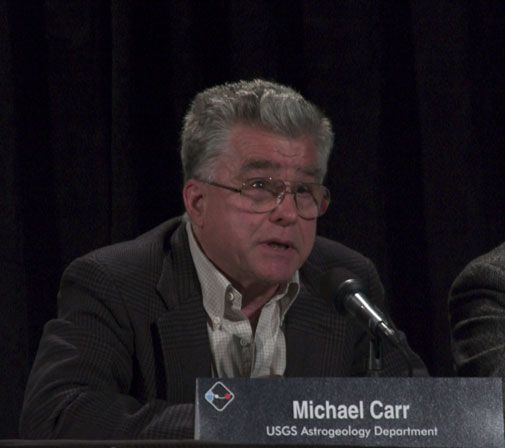Mars Needs Heroes
When it comes to Martian studies, Mike Carr wrote the book.
/https://tf-cmsv2-smithsonianmag-media.s3.amazonaws.com/filer/mikecarr-631-mar07.jpg)
When the 2005 film version of The War of the Worlds was released, director Stephen Spielberg remarked that the aliens could no longer come from Mars—spacecraft like Viking and Mars Pathfinder had forever changed the way we think about the Red Planet, and the mystery was gone. So, too, our space heroes would be believable only if they lived in “a galaxy far, far away.”
Mars already has heroes, however—real ones. And Mike Carr is one you should know about.
Physically, Mike isn’t a big man, probably a few inches over five feet. Despite living in the United States for more than 50 years, he still has a British accent. But it’s not one of those cool, I’m-about-to-kill-you James Bond accents. It’s very friendly. In fact, in the 20-odd years I have known him, Mike Carr always seems to be smiling. Sometimes he appears to be in deep thought, and occasionally his face hints at absolute surprise, but he always seems to be very happy. He’s the kind of guy you can easily imagine as a little boy, despite his being more than 70 years old.
Carr began his career as a planetary scientist at a time when there weren’t any. He started work as a metamorphic petrologist, but switched to geochemistry before graduating from Yale. He was subsequently hired by the University of Western Ontario to study the physics of shock—the behavior of materials subjected to sudden high-energy processes such as explosions. In September 1962, Gene Shoemaker, the father of modern planetary science, recruited Mike to the U.S. Geological Survey to begin studying shock processes as a means to understand impact cratering on the moon and other planetary bodies. Two years later Mike was conducting a study in which an explosive charge failed to detonate; he picked it up to investigate and was nearly killed. The accident left him blind in one eye. Undiscouraged, he continued working on a variety of projects, including scientific support for NASA’s Ranger and Lunar Orbiter spacecraft. He also became an important figure in mapping the surface of the moon in advance of the Apollo astronaut landings. When the planetary science branch of the U.S. Geological Survey moved to Flagstaff, Arizona, Mike decided to stay in Menlo Park, near San Francisco. Eventually he became chief of the USGS branch there. But his career was just getting started.
I was a teenager on vacation in July 1976 during the first U.S. spacecraft landing on Mars. Instead of going to the amusement park with my family, I sat in the hotel room watching the news reports on Viking 1. Like so many other kids, I had been hooked on space travel during the Apollo landings, and now here we were looking at the surface of Mars. Newspaper and television reports weren’t enough for me, though, and I began reading whatever else I could find, including popular science articles written by some of the mission scientists. As the lead investigator on the Viking orbiter camera team, Mike was particularly well qualified to discuss features on the Martian surface. I noticed that my favorite articles were always the ones he'd written, and they served as my introduction to planetary science. When I went on to graduate school, his book The Surface of Mars was one of my primary texts. To my generation of scientists, The Surface of Mars is the definitive source for understanding not just Mars but the evolution of scientific thought through the Mariner and Viking missions. It’s both a science and a history book.
My friend Ted Maxwell, the Associate Director for Research and Collections at the National Air and Space Museum, told me recently, “Mike hasn’t just written the book on Mars, he is the book on Mars.” He added: “Mike has served on absolutely every advisory committee NASA has had for exploring Mars.” He is the unquestionable authority on the planet’s geologic history, and he’s won just about every scientific award to prove it, including the National Air and Space Museum’s Trophy for Lifetime Achievement. Considering all the famous astronauts, pilots, and engineers in the running to receive this honor, it’s remarkable that a scientist would be selected. It’s even more remarkable that Mike was chosen the first year he was nominated.
As young scientists, my friends and I felt a sharp divide between ourselves and the generation that had been part of Apollo. To us, people like Mike Carr were legends. I certainly felt that way when, at a Mars science workshop in the early 1990s, Mike came over and sat with me during lunch. It was the first time I’d talked to him about anything, and I was overwhelmed to learn that Mike Carr was now reading articles I was writing! Most of our discussion was about my research. At that moment I felt I had arrived.
In some ways the exploration of Mars reflects life itself. A hundred years ago the planet was mostly a mystery, much as the world is to a child. As we grow up, reality takes away some, but not all, of the mystery. Some people become cynical or discouraged when they realize they’ll never have X-ray vision or be the first to walk on Mars. Others always find a reason to smile or be encouraging. Often these are the same people who aren’t afraid to put out new ideas for everyone to accept or reject.
I ran into Mike a few weeks ago. He’s retired now, but that hasn’t stopped him from releasing an updated edition of The Surface of Mars. The thing that got me is that he actually thanked me for my encouragement and my friendship through the years. Absolutely amazing. Now that’s a hero.
Posted February 27, 2007.
Bob Craddock is a geologist with the National Air and Space Museum’s Center for Earth and Planetary Studies.
